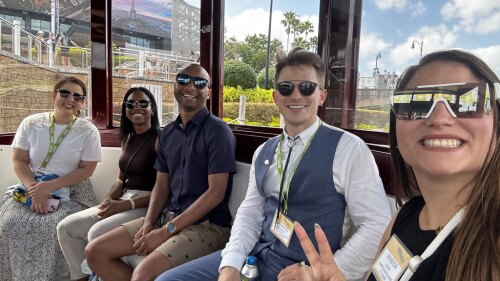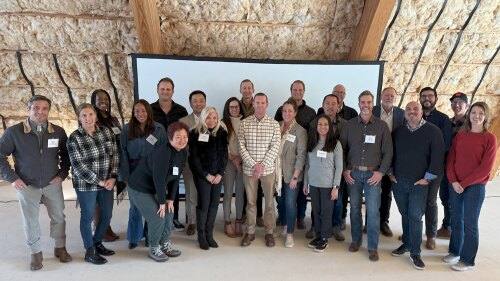A graduate student team from the University of Cincinnati, two teams from the University of Texas at Austin, and a team with students from the Massachusetts Institute of Technology and Harvard University have been selected as the four finalists for the 17th annual ULI Hines Student Competition, an ideas competition that challenges graduate students to devise a comprehensive design and development scheme for an actual site in an urban area.
This year’s competition involves the redevelopment of a site in Cincinnati comprising portions of a highway, the central business district, and the central riverfront along the Ohio River. Participants were tasked with evaluating the potential to deck the highway and combine it with adjacent parcels, with the ultimate goal of integrating both areas to create a vibrant, pedestrian-oriented, sustainable, mixed-use neighborhood. The competition, which began January 14, is designed to simulate an actual design, planning, and development scenario, and reflects Cincinnati’s vision for connecting the central riverfront entertainment district. The four teams are advancing to the final round of the competition in April, when they will compete for a $50,000 first-place prize.
Announcing 4 finalist teams for the #2019ULIHines Student Competition! Congrats @UofCincy @UTAustin(x2!) @MIT/@Harvard. #Cincinnati #realestate #urbandesign @UrbanLandInst @Hines @UTSOA @UTexasMcCombs @mitsap @MITdusp @MITarchitecture @MITSloan @HarvardGSD https://t.co/0Xv8vuLQYG pic.twitter.com/kv8CMZuAkB— Gretchen Sweeney (@GCSweeney1) February 20, 2019
To be competitive, submissions must create a comprehensive environment that is programmed, designed, built, and operated with all the elements necessary to promote the site as an integrated part of the city with high appeal to residents, workers, and visitors. The finalists’ development schemes are as follows:
- “The ANCHOR” from the University of Cincinnati—The ANCHOR not only bridges the riverfront to downtown but also binds the region. Promoting current and proposed transportation infrastructure, the ANCHOR becomes a place of convergence. The ANCHOR serves as a critical base for industries that endorse startup innovation, creativeness, and wellness on a regional scale. It expands the riverfront by constructing significant resilience strategies in the development of pedestrian thoroughfares and an extension of the river trail. The scheme envisions a destination with a user-centric focus that was created through collaboration that is regional in scope.
- “Cincinnati United” from the University of Texas at Austin—Cincinnati United seeks to reconsider the city’s southern edge as a welcoming gateway that honors the past, celebrates the future, and encourages unity and collaboration. The river boundary is reimagined as a boardwalk that hosts recreation and cultural expression for all. The boardwalk connects the site physically from east to west. A section of the boardwalk lifts above the historic Roebling bridge and anchors the site by joining with a community center. The new center is located directly across from the Underground Railroad museum and engages with it formally. This axis of history and activity facilitates a unified corridor beginning on the Kentucky side of the river and extending into the heart of Cincinnati.
- “The Landing” from the University of Texas at Austin—The Landing is Cincinnati’s gateway from a coal-powered industrial past into a sustainable future. The project’s emphasis on green infrastructure and renewable district energy production aligns with the Cincinnati Green Plan in its effort to make the city 100 percent reliant on renewable energy by 2035. The Landing solidifies Cincinnati as the model for the sustainable city of the 21st century, where green infrastructure projects create vibrant public and commercial spaces that encourage active social activity throughout the entire year.
- “The CincyStitch” from MIT and Harvard—The CincyStitch repositions a pivotal stretch of waterfront not as the city’s edge, but as the center of a connected region. Through four threads—culture and history, public realm, transportation, and new economies—the proposal strategically expands the site and creates connections to break down barriers across geography and time. Together, these four threads weave an urban tapestry rich in history but geared to the future; a 24-hour neighborhood bustling with city dwellers, and a center for new commerce that connects citizens across the region socially and physically.
The finalists were chosen from 90 entries judged by a jury of leading ULI members representing a broad variety of real estate disciplines. Hines Competition jury chairman and longtime ULI Foundation Governor Alex J. Rose pointed to the sophistication demonstrated in the proposals, which the teams prepared over 15 days’ time following receipt of the competition briefing materials in January. “What I found inspiring is the level of knowledge, creativity, and the volume of analyses that the students were able to produce without actually seeing the site, and their ability to synthesize all of that very quickly,” said Rose, senior vice president of Continental Development Corporation in El Segundo, California.
Rose noted that the competition challenges students to be innovative, but to also ensure that their proposals reflect reality, in terms of what is doable now and in years ahead. “The Hines Competition encourages students to think outside the box, but at same time, it forces them to say, ‘If I am going to propose something that may not seem to work now, I need to have a compelling story about why it will work 10 years or 25 years from now,’” Rose said.
Nine entries received Honorable Mention recognition:
- “Encore” from Cornell University;
- “Looping the Banks” from the Georgia Institute of Technology;
- “Elevate” from Harvard University;
- “Equilibrium” from Kansas State University and the University of Missouri–Kansas City;
- “We_” from Kansas State University and the University of Wisconsin–Madison;
- “EXPO Cincy” from Ohio State University;
- “The 8th Hill” from the University of Miami;
- “Cynapse Cincy” from Yale University; and
- “Over l Under” from Yale University.
During the last phase of the competition, the student finalist teams will have the opportunity to expand their original schemes and provide more detail for their plans. One member of each finalist team will receive an expenses-paid tour of the Cincinnati site (though other team members may also join the tour at their own expense). Information obtained during this site visit can then be used by the finalist teams in revising their presentations. At the competition finale on April 4, finalist team members will present their schemes in-person to the competition jury during a public forum in Cincinnati.
A $50,000 prize will be awarded to the winning team, with $5,000 of the total going to the university represented by the team. Each of the remaining three finalist teams will receive $10,000. In addition, Rose noted that each team will receive advice from the jury that is specific to each of their entries. “It is important that we give them constructive feedback, because as ULI members and land use professionals, we need to be educating the next generation of industry leaders,” Rose said.
We had such fun @UrbanLandInst last week opening the presentations for the #2019ULIHines Student Competition and seeing each team’s creative energy focused on #Cincinnati. Check out the competition challenge: https://t.co/5N590k9BrG > About the Competition. @Hines @ULICincinnati pic.twitter.com/SwVwM1BKbg— Gretchen Sweeney (@GCSweeney1) February 6, 2019
The competition jury consists of renowned experts from diverse backgrounds in real estate development. Jurors represent a strategic mix of land use professionals, including developers, architects, urban designers, urban planners, investment bankers, and financial analysts. In addition to Jury Chairman Rose, members of the jury are: Clete J. Benken, partner, MKSK, Covington, Kentucky; Andre Brumfield, urban strategies and design leader, principal, Gensler, Chicago; Merrie S. Frankel, president, Minerva Realty Consultants LLC, New York City; Suzette Goldstein, director of planning, HOK, Washington, D.C.; Richard M. Gollis, cofounder and principal, the Concord Group LLC, Newport Beach, California; Steven T. Kenat, principal and director of community development, GBBN, Cincinnati; Robert C. Lieber, executive managing director, C-III Capital Partners, New York City; Stephen P. Navarro, president and chief executive officer, the Furman Co., Greenville, South Carolina; Kevin Riley, chief operating officer and partner, North American Properties, Cincinnati; Lori Singleton, vice president and corporate design director, Smith Group, Ann Arbor, Michigan; and Charles L. Thomas, vice president and director, real estate equity investments, Eagle Realty Group, Cincinnati.
The ULI Hines Student Competition was created with a generous endowment from longtime ULI leader Gerald Hines, founder of the Hines real estate organization. The program is part of an ongoing ULI effort to raise interest among young people in creating better communities and improving urban development patterns, as well as increase awareness among students of the need for interdisciplinary solutions to design and development challenges.
The competition is strategically structured to encourage cooperation and teamwork—necessary talents in the planning, design, and development of sustainable communities—among future land use professionals and allied professions, such as architecture, landscape architecture, urban planning and design, real estate development, finance, historic preservation, engineering, and law.




